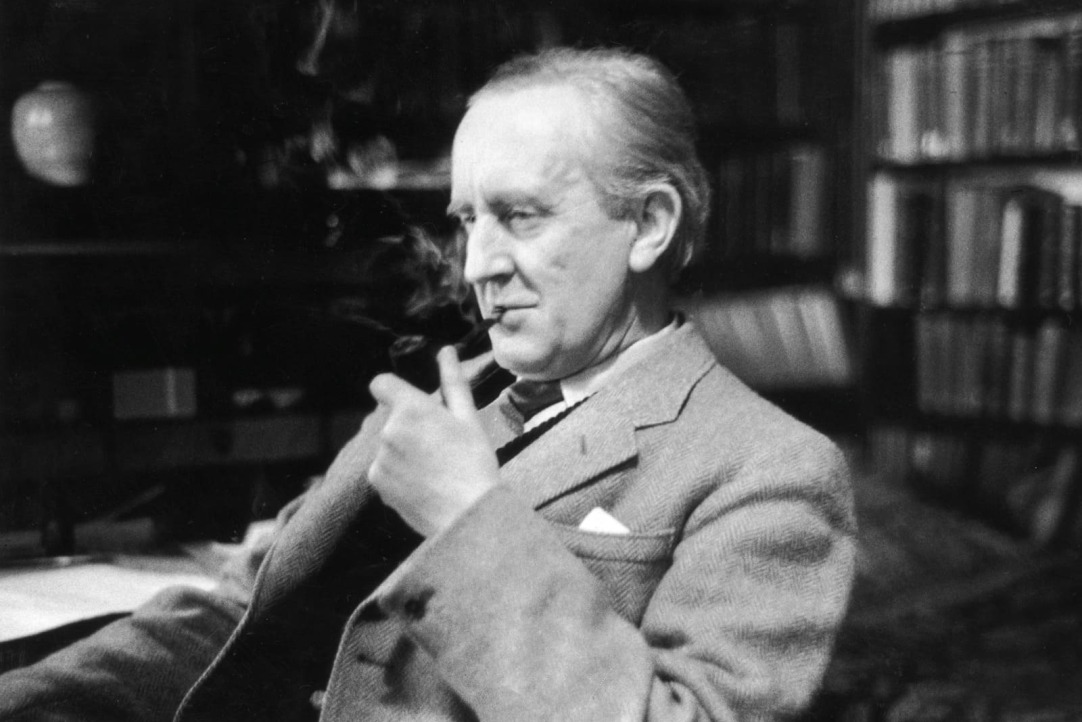The Great War and How It Reflected On Middle-Earth and Its Folks
Looking at the photos of cordial and friendly Tolkien smoking his pipe with a smile on his face, you would never think that this man had been through the horrors of war. It always seems that war leaves an indelible, visually accessible imprint on the image of a person. And Tolkien... well, can you imagine that this great bookworm, an admirer of old manuscripts and dead languages, was at war?

The war made me poignantly aware of the beauty of the world.
J.R.R. Tolkien
However, historical facts say the opposite: Tolkien really fought. Tolkien fought in the terrible and bloody Great War, took part in its most brutal battle and lost many comrades of his youth.
But perhaps the strangest and most peculiar thing about it all is the creative flourishing that Tolkien experienced during World War I. Perhaps his genius was stimulated in a situation of absolute social and universal crisis, or maybe his indefatigable consciousness tried to hide from the outer terrors and found refuge in his own endless fantasy.
This article will combine a kind of chronological analysis and synthesis of the events that happened to Tolkien during the Great War, and the development that transpired to his fantasy realm during this period. The main and most fundamental guide that contributed a great deal to this exact piece is the book by John Garth “Tolkien and the Great War: The Threshold of Middle-earth”, published in 2003 and deeply appreciated by Tolkienists: both amateurs and experts.
One of the main motifs of Tolkien's creations is the motif of home. Tolkien's heroes valued home above all else, fought for it and missed it dearly. Each story is imbued with longing and nostalgia for the homeland. But throughout all stories, home was unreachable for the characters: they were always disconnected from the place of their dreams, seeking for it in their fantasies and memories, when the harsh and only reality was an endless and dangerous path.
Hobbits, excited for the upcoming journey and madly in love with life, almost instantly found themselves face to face with a deadly threat. Tolkien himself once was such a “hobbit”, happily studying languages and composing unprecedented stories, sharing days and nights with like-minded friends and his beloved bride. But the year 1914 came and young English students along with half of the world were forced to take part in a terrible catastrophe, not yet aware of the consequences it was to bring.
In fact, British society was more engaged in what was happening than scared. The war seemed like a kind of competition, at the beginning no one took it seriously: everyone expected a quick triumphant victory and a happy family gathering on Christmas.
The tragedy dragged on for 4 long years with millions of dead and wounded. The contest turned into the Great War.
There’s always a question:
Why is “The Hobbit” a story for children with fascinating adventures and ambience of safety, when the Lord of the Rings, its sequel, is an epic and fateful saga offering the reader to steep in much more controversial and dismal issues? The source of this radical difference lies precisely in the War. It is pointless to deny the exceptional importance that the theme of war plays in Tolkien's legendarium. It is both the cause of misfortune and an incentive to action and unity. The war became the main antagonist in Tolkien's fate and left an ineffeceable mark on his works.
One of the key elements of the Tolkien story was the battle. There are at least 34 battles and 6 large-scale wars described in Silmarillion, The Hobbit and all of the Lord of the Rings books.
The detailness, clarity and truthfulness of the fights written by Tolkien only confirm the depth of the wounds that the Great War inflicted on him. After all, the trilogy of Middle-earth was published in 1954, 36 years after the end of WWI, yet how precisely and thoroughly the writer's consciousness reproduced the events that seemed to take place an eternity ago.
-
Now let's overlook the events of Tolkien's life during World War I in chronological order:
1914 – the beginning of WWI. Tolkien was in his final year of university, planning on finishing his education and while his friends were applying for mobilisation;
1915 – Tolkien and two dozen other young students still remained at Oxford and took their exams. Tolkien applied to join the army and was appointed a second lieutenant;
1916 – J.R.R. Tolkien received a degree, married Edith Bratt and started his service in France;
07/01/1916 – One of the bloodiest battles in history, the Battle of the Somme, began. After 5 months of grievous service, Tolkien fell ill and was hospitalised;
1917 – Tolkien tried to return to the front, but he was declared unfit for health reasons. He made several attempts to get back with breaks of months but the answer still remained negative;
11/16/1917 – Birth of Tolkien's first son, John;
1918 – the end of World War I;
1919 – the signing of the Treaty of Versailles, Tolkien was officially demobilised
Tolkien's military experience was brief, nevertheless, it collected all possible horrors. To be thrown into the most horrific battle, to receive weekly notifications about deaths of dear friends and live in constant uncertainty whether you are ever to return home.
But the pain was also brought by the inability to return to the front after the illness, to protect England.
It is believed that the first concrete stories about Arda and Middle-earth were written by Tolkien during the Great war, and it was then that a more complete image of his legendarium began to take shape. These stories are stored in The Book of Lost Tales: Part Two, published by Christopher Tolkien in 1984. This compilation includes the first stories about Beren and Lúthien, the Dragon, dwarves, as well as an exhaustive dictionary of the Elvish language.
The fact that the evil of Middle-earth is a clear reproduction from the Fascist union is indisputable. The mechanical component of unquestioning submission and the idea of conquest seems to be copied from Hitler's ideology. Tolkien’s evil was industrialised, it cut off everything human, alive, and hitherto known. It poisoned the earth and peoples.
But along with the image of villainy, Tolkien’s legendarium absorbed the nature of fellowship and solidarity in the face of danger, which he observed hourly among his comrades. Not only Mordor, Sauron, orcs found their primary sources in the Great War. The courage, cohesion and mutual assistance of the protagonists of Middle-earth were inspired by the brotherhood which Tolkien experienced himself. There was harmony between them during the period of absolute apocalypse and the greatness of such a phenomenon cannot be ignored.
It is also quite comprehensible that Frodo “inherited” his deadly wound from the soldiers of the Great war. The wound that cannot be seen yet drives its owner mad from pain and flashbacks. Tolkien felt it and saw it in his own self and others who had gone through the terrors of war.
Tolkien's creations are imbued with the spirit and ache of the Great War, making us understand the extent of his own trauma. But what it truly proves is J.R.R. Tolkien’s pure genius and boundless force of his mind.
Tolkien did not take direct part in the Second World War and during this period worked on The Lord of the Rings trilogy, which was published in 1954 and took about 15 years to complete.
Karima Lakekhal
References
- Garth J. Tolkien and the Great War: the Threshold of Middle-earth. – HMH, 2013.
- Loconte J. A hobbit, a wardrobe, and a great war: how JRR Tolkien and CS Lewis rediscovered faith, friendship, and heroism in the cataclysm of 1914-18. – Thomas Nelson, 2015.
- Croft J.B. The Great War and Tolkien's Memory: An Examination of World War I Themes in" The Hobbit" and" The Lord of the Rings" // Mythlore. – 2002. – Т. 23. – №. 4 (90. – pp. 4-21.


